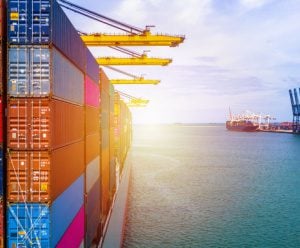
Uptick in schedule reliability among positives for ocean freight

Back in January, soft export volume out of China, both before and after the Lunar New Year holidays, was partially due to labor shortages related to COVID-19 and holiday absences.
However, lowered consumer demand in North America and Europe, where key economies are struggling with high inflation and slow, or non-existent, economic growth, have also played a critical factor in the market outlook.
With capacity and demand constantly seeking the much-wanted balance, this month's biggest news is the end of the 2M alliance.
Shifting landscape from dissolving 2M alliance
The carrier network split between MSC and Maersk had been predicted for quite some time, with many questions related to its impact.
Taking questions during the company’s full-year and Q4 results presentation in February, Maersk’s CEO Vincent Clerc explained the end of the vessel-sharing agreement with MSC would not induce a full-scale shake-up of the alliance system. Instead, he insisted it would result in four east-west networks instead of three.
The February DHL Ocean Freight Market Update notes that there is no immediate impact on services provided under the 2M agreement. It will, however, trigger fundamental discussions amongst the carriers. An important reshuffle of the carrier landscape is likely, changing the course of business in the major East-West trades.
Alan Murphy, CEO of Sea-Intelligence, added that while the formal break-up will not happen until January 2025, gradual changes are likely during the transition period over the next two years.
On the trans-Pacific trade, and assuming that carriers take delivery of new vessels and cascade them internally through their networks, this would leave Maersk as clearly the smallest of the major carriers and alliances, with an operated capacity only matching the combined niche carriers in the trade.
Healthy active fleet amidst shifting spot freight rates
With spot freight rates shifting downward, carriers have adopted capacity reduction strategies, including blank sailings and reducing ship speeds, otherwise known as slow steaming.
According to the February DHL Ocean Freight Market Update, Asia Pacific-Europe services are experiencing a current blank sailing program that “is balancing out demand with -27 percent of capacity until the middle of February”. Further blank sailings are likely as carriers try to “stabilize the market”.
“The blank sailings have been disruptive, but we are now seeing signs that schedules are becoming reliable, with 56.6 percent global reliability in November 2022,” said Kelvin Leung, CEO, DHL Global Forwarding Asia Pacific. “We expect this trend to improve in the coming months.”
Even though more blank sailings are scheduled and slow steaming is now common across trade lanes, the inactive fleet remains a relatively small proportion of overall capacity, albeit a growing one.
After a brief dip earlier in the month, the global fleet of inactive container ships was back on an upward trajectory by the end of January, noted Alphaliner in a report published in the first week of February. The analyst firm noted that the number of container ships counted as inactive rose by 78 units to reach 338 vessels, raising the inactive fleet capacity from194,705 twenty-foot equivalent unit (TEU) to reach 1,477,606 TEU.
This represents 5.7 percent of the global fleet compared to only 4.9 percent two weeks earlier. According to Alphaliner, even with the slow steaming measures and the deferment of newbuilding deliveries, the softening freight rates and cargo volumes continue to push the amount of commercially idle tonnage up. This unemployed fleet, however, is growing somewhat slower than expected.
Hopes of improving demand
Demand levels and carrier strategies will determine the accuracy of such forecasts. There are signs that the former could recover faster than many economists had expected. The rise in container pick-up charges in China suggest that operators could be preparing for an early bounce back once China’s factories return to full output after the Lunar New Year holidays.
According to the January 2023 reading of the J.P. Morgan Global Manufacturing PMI, the global manufacturing slowdown is also showing signs of easing, with a reading of 49.1 representing a clear improvement from 48.7 in December 2022.
The survey's Output Index, which acts as an advance indicator of worldwide factory production trends, signaled a second successive month of slower decline. That index rose to its highest since August 2022, indicating that the global manufacturing downturn reached its lowest point in November 2022.
“Rising business optimism, an improved orders-to-inventory ratio and a boost to growth as China re-opens should also provide a boost in the months ahead,” said Bennett Parrish, Global Economist at J.P. Morgan.
However, only nine out of the 31 nations for which January data were available signaled expansions in output. The few pockets of growth were largely confined to Asia where India, Indonesia, Russia, the Philippines, Thailand and Myanmar all registered increases.
“I think it is clear that the uber-growth in ocean shipping volumes during Covid-19 lockdowns is now over,” said Dominique von Orelli, Global Head, Ocean Freight, DHL Global Forwarding. “Orders are back to normal, but importers remain cautious with bookings primarily due to relatively high inventory levels and wariness of where consumer demand is headed. But, in general, we are seeing signs of an improving business environment and expecting gradual demand improvements as the year progresses.”









 English
English